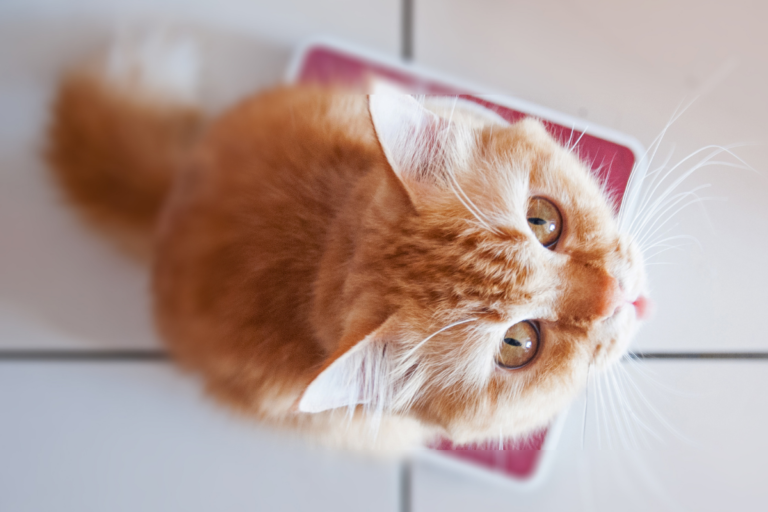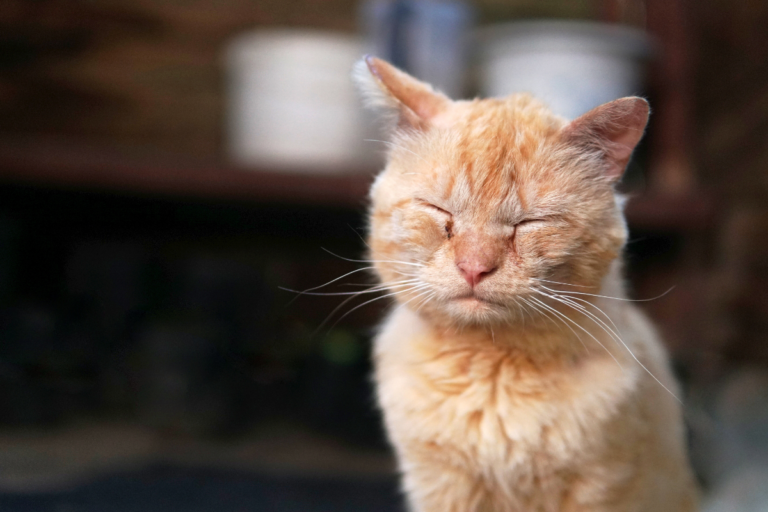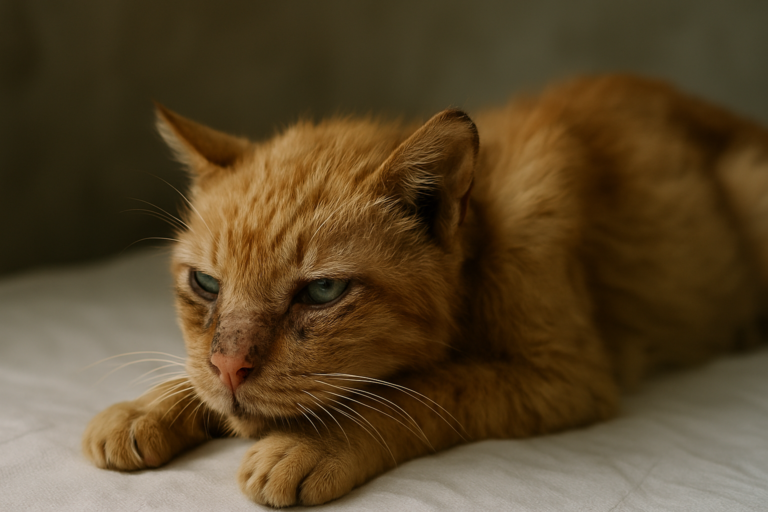Cat Parents Alert: Unmasking Cat Fleas Symptoms
Recognizing Flea Symptoms
Spotting fleas on our cats isn’t just about the itch factor; it’s about keeping them healthy and happy. These tiny invaders can lead to more than a little discomfort for our feline pals.
Signs of Flea Infestation
Wondering if our cats have picked up some unwanted hitchhikers? Let’s check out these not-so-friendly signs:
- Excessive Scratching or Grooming: If our furry friend is scratching like there’s no tomorrow, especially when the weather is warm and sticky, fleas might be the culprits.
- Flea Dirt: Those little black specks in our cat’s fur? They look like someone sprinkled black sand and are a classic sign of fleas. Use a fine comb on a white towel to spot them.
- Hair Loss or Red and Inflamed Skin: Flea bites can cause the skin to get red and puffy, leading to bald spots.
- Pale Gums: Especially in kittens, pale gums mean fleas could be draining them, leading to anemia (PetMD).
- Visible Fleas: If we spot little black dots scurrying around the tail or under the armpits, we’re looking at live fleas in action (PetMD).
| Signs of Flea Infestation | Description |
|---|---|
| Excessive Scratching | Lots of itching, often in warm climes |
| Flea Dirt | Black, sandy specks in the fur |
| Hair Loss | Bald, red-looking skin patches |
| Pale Gums | Warning of anemia, especially in kids (kittens) |
| Visible Fleas | Spotting tiny, moving dots on the skin |
Symptoms of Fleas in Cats
If fleas have crashed the party, here’s how we’ll know they’ve overstayed their welcome:
- Persistent Scratching and Biting: Our cats will be at it again, scratching and biting their skin non-stop.
- Restlessness: With fleas causing them misery, a peaceful nap is impossible.
- Lethargy: Especially among kittens, loss of pep can be linked to flea-induced anemia.
- Decreased Appetite: Flea misery can make cats turn their noses up at dinner.
- Red Bumps and Scabs: Those bites leave behind tiny red marks and sometimes scabs.
- Grooming Behavior Changes: Overzealous grooming might be a cat’s way to tell fleas, “You’re not welcome here.”
| Symptoms of Fleas in Cats | Description |
|---|---|
| Persistent Scratching | Non-stop biting and scratching |
| Restlessness | Cats can’t sit still due to discomfort |
| Lethargy | Specially in kittens, a drop in energy levels |
| Decreased Appetite | Food interest takes a nosedive |
| Red Bumps/Scabs | Tiny red marks or scabs caused by bites |
| Grooming Changes | Cats going overboard with grooming |
For more smart tips on dealing with fleas in cats, check out our section on flea allergy dermatitis. Also, take a peek at our resources on feline kidney disease symptoms and cat gum disease to keep other cat problems at bay.
By catching these flea clues early, we can kick fleas to the curb and help our cats feel comfy again. For extra advice, browse through our guide on managing flea infestations.
Dandruff in Cats
We’re diving into cat wellness today, with a zoomed focus on those little flakes you might spot in your kitty’s fur—dandruff, our fluffy buddies’ version of skin woes. Getting a handle on cat dandruff is pretty key to keeping them happy and healthy.
Understanding Feline Dandruff
Dandruff in cats happens when their skin starts flaking, leaving little specks in their fur. These can look gray or white and are often paired with a scratch itch to the skin. Regular brushing is like a mini massage, spreading those natural oils around, picking up loose hairs, and kicking stubborn dead skin to the curb. But, a word to the wise—chat with your vet before you switch up the grooming game, especially if the flakes are taking over.
Causes and Symptoms
Dandruff can pop up for all kinds of reasons. It’s a bit of a mixed bag, and figuring out why your cat’s got the snow globe look is step one in sorting it out. Here’s what might be going on:
- Bugs on Board: Little critters like fleas or mites can bug your cats and set off skin irritation that waves dandruff’s flag.
- Unwelcome Guests: Sometimes, bacteria or fungi make a home in your kitty’s coat, paving the way for flaky skin.
- Food Fumbles: If the diet’s off-track or allergies are lurking, skin might show the first SOS.
- Dry Zones: Living where the air’s parched can be rough on a cat’s skin.
- Underlying Issues: Health woes such as extra pounds, diabetes, or other sneaky problems.
When dandruff makes an appearance, you might see:
- Those oh-so-visible flakes.
- Excessive scratching.
- Red or irritated skin, sometimes venturing into sores or bald spots that scream for vet help.
| What Starts It | What You See |
|---|---|
| Parasites | Flakes, scratchy scratch |
| Infections | Red skin, maybe sores |
| Food Slip-Ups | Skin flake city, dull fur |
| Dry Atmosphere | Skin feeling the desert |
| Health Concerns | Bald spots, sores |
Treatment for your cat’s dandruff is like a detective story—it needs the right culprit to get the right fix. Fleas causing chaos? Then, flea control’s the hero. Infections? Time for some vet-prescribed meds. It’s also about the all-important mix of good food, regular grooming, and perhaps tweaking the home environment.
If your cat’s shedding more than usual—flakes, not fur—get in touch with your vet. They’ll have the right answers to tackle dandruff, ensuring your cat’s getting the care they need. For more feline facts, like keeping those teeth in check or ensuring they’re maintaining a purrfect weight, check out our other resources.
Flea Allergy Dermatitis
Flea allergy dermatitis (FAD) is one itchy issue for cats, causing a whole lot of trouble. Figuring it out and getting it sorted is super important for keeping our furry pals healthy and happy.
Effects on Cats
Imagine a cat’s immune system going a bit bonkers over flea spit — that’s FAD in action! It’s quite common, especially in cats with other allergy-related quirks. Here’s how to spot the tell-tale signs:
- Constant itching and scratching
- Grooming like there’s no tomorrow
- Bald patches cropping up
- Scabs and crusty bits showing up
- Skin looking pretty irritated
- Pesky tapeworms hanging around the tush
These symptoms throw a cat’s comfort right out the window, leading to bad skin and nasty secondary infections from all that scratching.
Diagnosis and Treatment
When it comes to finding out what’s going on, cats are sneaky. Their grooming habits can hide those little flea dirt clues. But fear not, we’ve got tests to the rescue:
- Skin tests kinda like what humans get
- Fancy blood tests for those in the know (VCA Hospitals)
Once we’ve got a diagnosis, it’s all hands on deck for kicking those fleas to the curb:
- Flea Control: Boot the fleas off your kitty and out of its home turf.
- Flea Zappers: Use products that’re feline-friendly to boot those fleas.
- Housekeeping Heroics: Dust off that vacuum and get washing, especially the kitty’s hangout spots.
- Environmental Warriors: If all else fails, call in the exterminators (Cornell Feline Health Center).
Jumping on these solutions quickly will help chill out your cat’s symptoms and bring back the zen. For more tips on reclaiming your home from fleas, check out our thoughts on getting rid of those pesky bugs.
| Symptom | Description |
|---|---|
| Itching & Scratching | Cat’s turning into a scratch machine |
| Excessive Grooming | Grooming overload, especially in bald spots |
| Hair Loss | Patches of skin showing through |
| Skin Irritations | Scabby, crusty, altogether red skin |
| Tapeworms | Sneaky white bits near the tail |
For more on keeping our feline friends in fine fettle, explore our guides to cat health issues, worm warnings, and general kitty sickness. Keeping our cats comfy and disease-free is a big deal, so we hope this info helps in tackling flea allergy dermatitis head-on.
Managing Flea Infestations
Getting rid of fleas isn’t just about taking care of your furry friend. You gotta make sure both your buddy and your crib are flea-free zones. Let’s jump into some handy tips and tricks to keep those pesky critters away for good.
Prevention Tips
Stopping fleas before they start is kinda like locking the doors before trouble walks in. Here’s how to keep those creepy crawlers out of your cat’s fur:
-
Regular Check-ups: Peek through your cat’s fur like you’re looking for buried treasure—treasure that you don’t wanna find. A fine-toothed comb is your best friend here, especially when the weather’s warm and fleas are throwing parties. Look for black stuff that looks like pepper; that’s flea poop! (Cornell Feline Health Center).
-
Flea Preventatives: Get your vet-in-the-loop on flea preventatives. Whether it’s drops, pills, or collars, make sure it’s all good for your cat. Your vet knows best!
-
Grooming: Bath time isn’t just for the ‘gram. Regular baths and brushing help you spot fleas early and keep your cat’s coat all shiny and healthy.
-
Clean Bedding: Toss your cat’s bedding into the hot wash cycle regularly. Heat’s no friend to fleas and their little flea eggs.
-
Outdoor Control: Keep your yard flea-free by mowing the lawn and raking away leaf piles. Less clutter means fewer flea hideouts.
For more tidbits on keeping your kitty in tip-top shape, head over to our section on cat disease.
Environmental Control Measures
Tackling fleas means attacking on all fronts. These guys are sneaky, hiding in your carpets and furniture like pros. So, let’s roll up those sleeves:
-
Vacuuming: Suck it up! Vacuum those areas your cat loves hanging out in, hitting carpets, rugs, and furniture. Dispose of that vacuum junk right away so the cycle doesn’t repeat.
-
Flea Traps: Sticky traps aren’t just for catching mice. Use flea traps to see if the little parasites are still around, lured by light and heat.
-
Steam Cleaning: Feel the heat! Steam clean the heck out of your carpets and couches. It’s like a spa day that ends fleas at all stages of their life.
-
Flea Sprays: Spray those nooks and crannies with home-use chemical spritzers. Follow the instructions, and keep your cat outta there till it’s all clear.
-
Professional Extermination: When all else fails, call in the big guns. Pros can make sure those fleas don’t stand a chance (Cornell Feline Health Center).
Here’s a cheat sheet for environmental control:
| Measure | Description |
|---|---|
| Vacuuming | Kick fleas out of your carpets, rugs, and furniture |
| Flea Traps | Set traps with lights to catch fleas |
| Steam Cleaning | Knock out fleas with some steam |
| Flea Sprays | Spritz your home to handle fleas |
| Professional Extermination | Call the pros to finish the job |
By sticking to these tips and home hacks, you can say goodbye to flea troubles, ensuring your kitty lives in comfort and peace. For more on keeping your kitty healthy, don’t miss our piece on cats worms symptoms!






